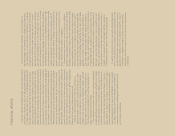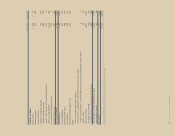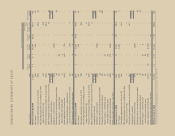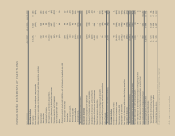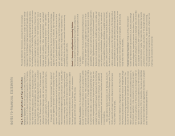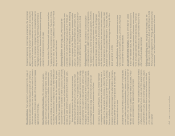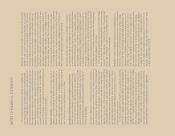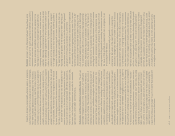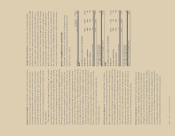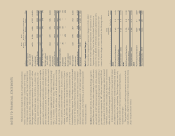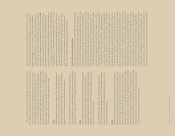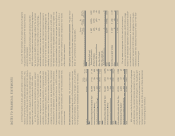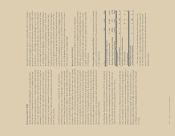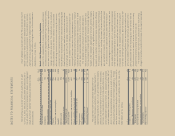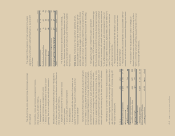Sara Lee 2011 Annual Report Download - page 87
Download and view the complete annual report
Please find page 87 of the 2011 Sara Lee annual report below. You can navigate through the pages in the report by either clicking on the pages listed below, or by using the keyword search tool below to find specific information within the annual report.
Cooperative Advertising
Under these arrangements, the corporation
agrees to reimburse the reseller for a portion of the costs incurred
by the reseller to advertise and promote certain of the corporation’s
products. The corporation recognizes the cost of cooperative advertis-
ing programs in the period in which the advertising and promotional
activity first takes place. The costs of these incentives are generally
included in the determination of net sales.
Fixtures and Racks
Store fixtures and racks are given to retailers
to display certain of the corporation’s products. The costs of these
fixtures and racks are recognized as expense in the period in which
they are delivered to the retailer.
Advertising Expense Advertising costs, which include the
development and production of advertising materials and the com-
munication of this material through various forms of media, are
expensed in the period the advertising first takes place. Advertising
expense is recognized in the “Selling, general and administrative
expenses” line in the Consolidated Statements of Income. Total
media advertising expense for continuing operations was $199 mil-
lion in 2011, $202 million in 2010 and $152 million in 2009.
Contingent Sale Proceeds The corporation sold its European
cut tobacco business in 1999. Under the terms of that agreement,
the corporation was to receive an annual cash payment of €95 mil-
lion if tobacco continued to be a legal product in the Netherlands,
Germany and Belgium through July 15, 2009. The contingencies
associated with the final payment in 2010 and prior payments passed
in the first quarter of each fiscal year and the corporation received
the annual payments and recorded income in the contingent sales
proceeds line in the Consolidated Statements of Income. The pay-
ments received increased diluted earnings per share by $0.19 in
2010 and $0.21 in 2009.
Cash and Equivalents All highly liquid investments purchased
with a maturity of three months or less at the time of purchase
are considered to be cash equivalents.
Accounts Receivable Valuation Accounts receivable are stated
at their net realizable value. The allowance for doubtful accounts
reflects the corporation’s best estimate of probable losses inherent
in the receivables portfolio determined on the basis of historical
experience, specific allowances for known troubled accounts and
other currently available information.
Shipping and Handling Costs Shipping and handling costs are
$461 million in 2011, $460 million in 2010 and $510 million in 2009.
These costs are recognized in the “Selling, general and administra-
tive expenses” line of the Consolidated Statements of Income.
Reacquired Shares The corporation is incorporated in the state of
Maryland and under those laws reacquired shares are retired. As
shares are reacquired, the cost in excess of par value first reduces
capital surplus, to the extent available, with any residual cost applied
against retained earnings.
Sales Recognition and Incentives The corporation recognizes
sales when they are realized or realizable and earned. The corpo-
ration considers revenue realized or realizable and earned when
persuasive evidence of an arrangement exists, delivery of products
has occurred, the sales price charged is fixed or determinable, and
collectibility is reasonably assured. For the corporation, this gener-
ally means that we recognize sales when title to and risk of loss of
our products pass to our resellers or other customers. In particular,
title usually transfers upon receipt of our product at our customers’
locations, or upon shipment, as determined by the specific sales
terms of the transactions.
Sales are recognized as the net amount to be received
after deducting estimated amounts for sales incentives, trade
allowances and product returns. The corporation estimates trade
allowances and product returns based on historical results taking
into consideration the customer, transaction and specifics of each
arrangement. The corporation provides a variety of sales incentives
to resellers and consumers of its products, and the policies regard-
ing the recognition and display of these incentives within the
Consolidated Statements of Income are as follows:
Discounts, Coupons and Rebates
The cost of these incentives
is recognized at the later of the date at which the related sale is
recognized or the date at which the incentive is offered. The cost of
these incentives is estimated using a number of factors, including
historical utilization and redemption rates. Substantially all cash
incentives of this type are included in the determination of net sales.
Incentives offered in the form of free product are included in the
determination of cost of sales.
Slotting Fees
Certain retailers require the payment of slotting fees
in order to obtain space for the corporation’s products on the retailer’s
store shelves. The cost of these fees is recognized at the earlier of
the date cash is paid or a liability to the retailer is created. These
amounts are included in the determination of net sales.
Volume-Based Incentives
These incentives typically involve rebates
or refunds of a specified amount of cash only if the reseller reaches
a specified level of sales. Under incentive programs of this nature,
the corporation estimates the incentive and allocates a portion
of the incentive to reduce each underlying sales transaction with
the customer.
84/85 Sara Lee Corporation and Subsidiaries





